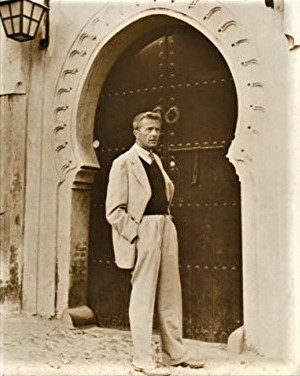
Grove Koger
Today’s post is devoted to a late work by Paul Bowles, who was born December 30, 1910, and died November 18, 1999. Most of the text is drawn from a review I published in the November/December 1987 issue of The Bloomsbury Review.
□□□
Paul Bowles: Points in Time (Ecco P., 1982)
Was it Gertrude Stein or Alice B. Toklas who first sent the young American Paul Bowles to Morocco? Bowles’ own accounts vary. In any case, he spent several months there in 1931. By 1934 he had visited North Africa several times, and in 1947 he returned to Morocco for good. Along the way the accomplished composer who had studied with Aaron Copland became an accomplished writer, and, before long, America’s most distinguished expatriate.
Not unexpectedly, Bowles’ adopted home figures prominently in his work. Four of his five novels are set in Morocco or neighboring Algeria, including his most famous, The Sheltering Sky (1949), as well as most of his many stories.

In 1982, Bowles published a stunning new work that conveyed the inner experience of his adopted home better than any of his previous writings and brought together the composer and writer. But its publication was greeted with virtual silence; perhaps critics found the book too brief or elusive to get an easy grip on.
Points in Time consists of eleven sections, one of them all of sixty words long and a few the length (and shape) of short stories, arranged chronologically from the earliest times to the day before yesterday. The collection opens with a glimpse of Morocco’s Atlantic coastline as it must have looked to Hanno, the Carthaginian traveler who sailed through the Strait of Gibraltar and down the West African coast about 500 B.C.E. Many of the subsequent episodes explore the relationship between Moslems, Jews, and “Nazarenes,” or Christians.

One of the best pieces, which is apparently based on a true incident, concerns one Andrew Layton, an English exporter living in the windy seaside town of Essaouira two centuries ago. Layton becomes involved in a fracas with some farmers and in anger strikes a woman in the face with his whip, dislodging two of her teeth. All parties are called before the Sultan in Marrakech, where Layton straightforwardly admits the crime and the farmers successfully press their demand for “precise retaliation.” What follows is pure Bowles:
Layton “had the presence of mind to ask that the teeth to be pulled be two molars which recently had been giving him trouble. The complainants agreed to the suggestion. Back teeth being larger and heavier than front teeth, they felt that they were getting the better of the bargain.
“The operation went ahead under the intent scrutiny of the villagers. They were waiting to hear the infidel’s cries of pain. Layton, however, preserved a stoical silence throughout the ordeal. The molars were washed then presented to the claimants, who went away entirely satisfied.”
Impressed with Layton’s composure, the Sultan befriends him, hoping that eventually Layton might become British Consul in Marrakech. But no, he will stay in Essaouira. “He had got used to the wind, he said.”
He had got used to the wind …
Disputes among people of various religions and nationalities, among the colonizers and the colonized, are usually settled less satisfactorily. “At night in the courtyards of the Rif, grandfathers fashion grenades. Each rock in the ravine shields a man. The Spaniard in the garrison starts from sleep, to find his throat already slashed.”
Ecco Press promoted Points in Time as a novel, a pretty elastic term that nevertheless is misleading in this case. Points in Time resembles nothing so much as a suite, a form favored by Bowles in his composing days. (There’s even a translation here of an anti-American song popular n Morocco in the 1950s.) Every word counts, and each is carefully chosen so that the effect is precisely musical, however varied the movements. In Points in Time, Paul Bowles the composer has returned to collaborate with Paul Bowles the writer to produce their most important work, a resolutely unromanticized suite morocaine drawn from that country’s extravagant history. It was worth the wait.
□□□
The jacket of Points in Time was designed by Cathy Saksa, and the photograph of Paul Bowles was taken in Tangier. The map of Morocco is by 16th-century cartographer Abraham Ortelius, and is reproduced in black and white on the endpapers of Points in Time; north and the southern coasts of Spain and Portugal are to the right.